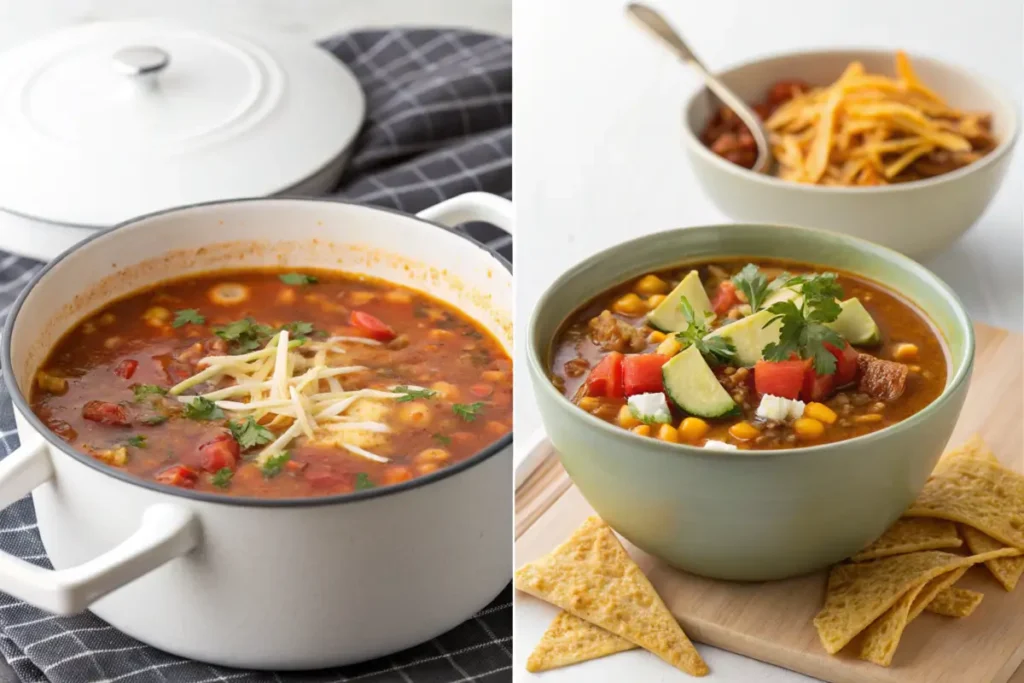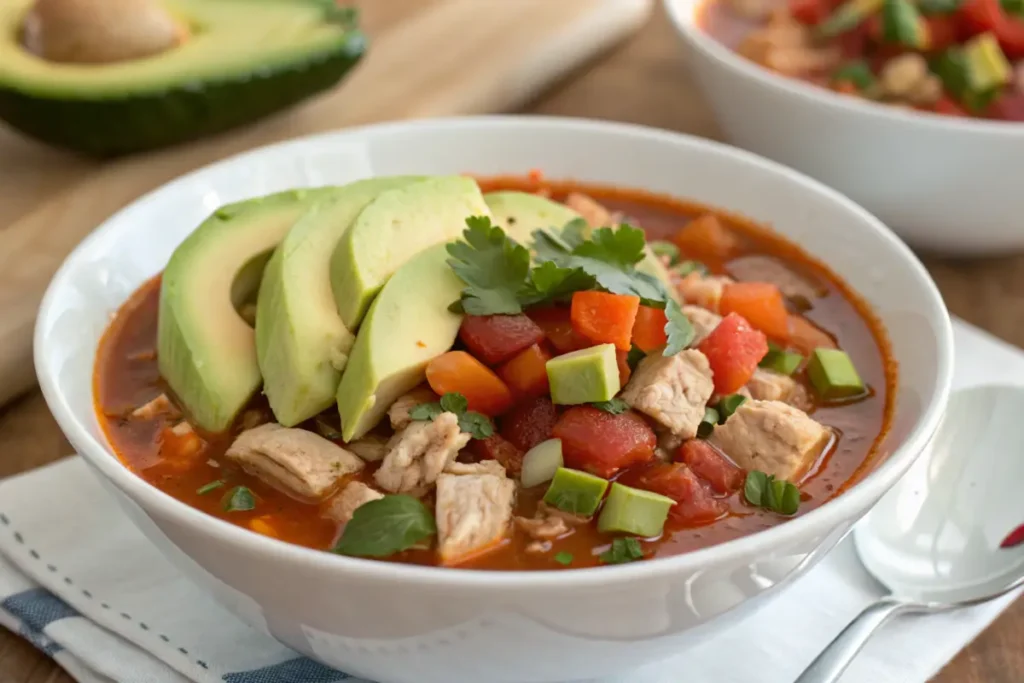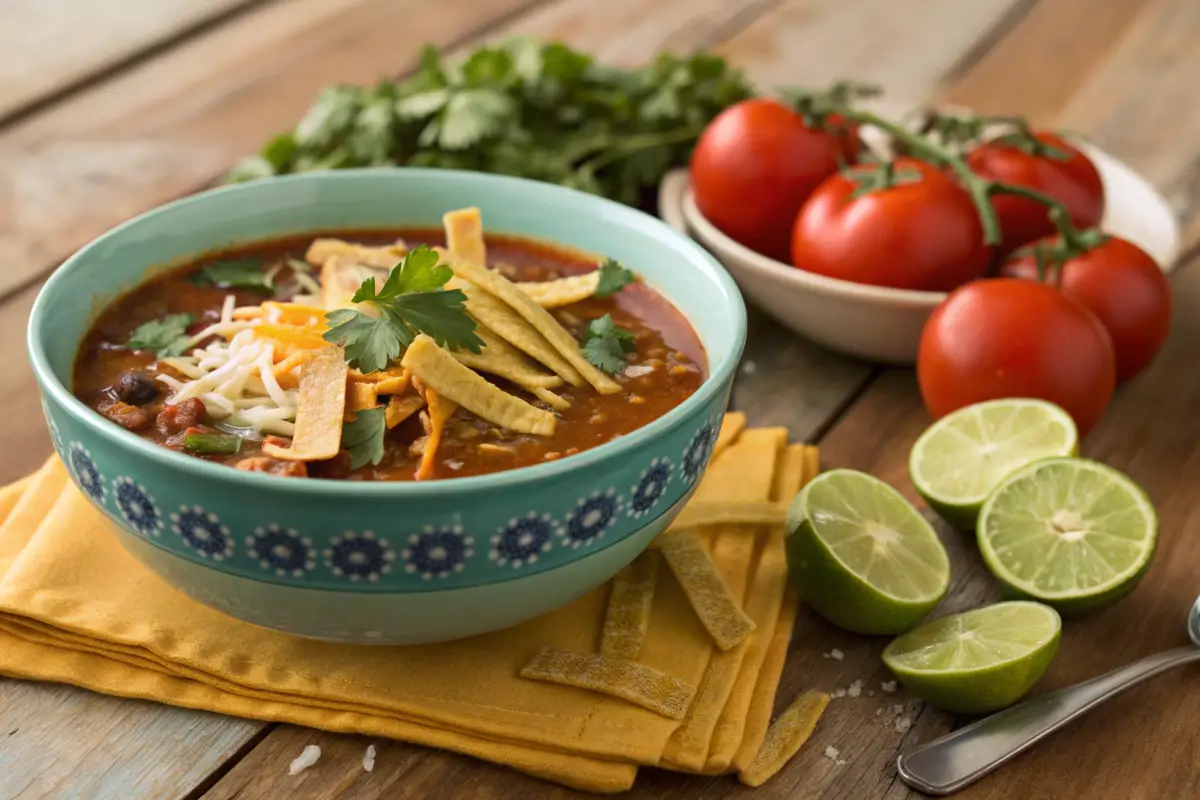Taco soup is a flavorful, hearty dish that blends Mexican culinary traditions with modern comfort food sensibilities. Its rich history and dynamic evolution reflect a tapestry of cultural influences, regional adaptations, and creative innovations. This article delves into the fascinating origin of taco soup, its relationship to the iconic taco, and how it has transformed into a global favorite. We’ll also explore traditional ingredients, modern twists, and why taco soup has become a staple for many. Let’s dive in!
To fully understand what is the origin of taco soup?
The Birthplace of Taco Soup
The exact origin of taco soup is a bit of a culinary mystery, but its roots are deeply tied to Mexican culture. While the taco itself dates back to the Aztecs, who filled maize tortillas with various meats and spices, the concept of combining these elements into a soup likely emerged as an adaptation for practicality and warmth. Some food historians believe taco soup was first popularized in border towns, where Mexican and Tex-Mex cuisines began to merge.
In these regions, cooks sought to create a dish that preserved the bold flavors of tacos while offering the heartiness of a stew. The result? A rich, spiced soup that could feed families with ease and comfort. From humble beginnings, taco soup quickly gained popularity, especially in Southwestern U.S. states like Texas, New Mexico, and Arizona.
Cultural Significance in Mexican Cuisine
In Mexican cuisine, soups and stews hold a place of deep cultural importance. Dishes like pozole, caldo de res, and sopa de tortilla are staples of family gatherings and festive occasions. Taco soup, with its fusion of ingredients like beans, tomatoes, and ground beef, reflects this heritage while embracing Tex-Mex influences.
This hybrid dish represents more than just a meal; it’s a symbol of culinary adaptability. Taco soup became a bridge between traditional Mexican cooking and the fast-paced, convenience-driven food culture of the United States. It carried the essence of tacos—the spice, the savoriness—into a warm, comforting bowl.
Comparison with Traditional Mexican Soups
When compared to traditional Mexican soups, taco soup stands out for its simplicity and accessibility. Unlike the intricate preparation required for pozole, which involves hominy and slow-cooked pork, taco soup is a one-pot wonder. It borrows elements from sopa de tortilla, such as the use of tortilla chips as a topping, but incorporates Tex-Mex staples like canned beans, corn, and ground meat.
In this way, taco soup offers a fusion of ancient traditions and modern convenience, making it a beloved dish for both busy weeknights and cozy gatherings.
Evolution of Tacos and Their Relation to Soup
The Origin of the Taco: From Street Food to Soup
Tacos have a long and storied history, tracing back to the Aztec era when simple maize tortillas were filled with ingredients like fish and roasted insects. Over time, the taco evolved, becoming a beloved street food in Mexico. The creation of taco soup marked an innovative shift, blending the essence of tacos with the warmth and convenience of a soup. As Mexican cuisine spread globally, taco soup emerged as a Tex-Mex favorite, embodying the vibrant flavors of its predecessor while offering a comforting, one-pot meal.
The transition from taco to soup may seem unusual at first, but both dishes share a foundational use of bold spices and hearty ingredients. Taco soup became a practical way to enjoy taco flavors without the need for tortillas, making it ideal for families and large gatherings.

Transformation of Ingredients Over Time
Historically, tacos incorporated fresh and locally available ingredients. Similarly, the earliest versions of taco soup relied on staples like beans, tomatoes, and chilies. However, modern taco soup has seen the addition of canned goods, pre-made seasonings, and toppings like sour cream and shredded cheese. This evolution reflects a shift toward convenience while maintaining the robust taste that defines Mexican-inspired dishes.
One notable change is the increasing customization of taco soup. From vegetarian adaptations to versions loaded with beef or chicken, taco soup can cater to various dietary preferences, making it a truly versatile dish.
Regional Variations in Taco Soup Preparation
Taco soup recipes vary widely depending on regional influences. In the Southwestern United States, for instance, it often includes black beans, corn, and green chilies. Meanwhile, in Mexico, traditional soups like caldo tlalpeño and sopa de tortilla serve as inspiration, offering smoky, spicy undertones that echo the taco’s rich history. This regional diversity highlights the dish’s adaptability and enduring appeal.
Traditional Ingredients and Their Symbolism
Essential Ingredients in Taco Soup
A classic taco soup recipe typically includes ground beef, onions, garlic, tomatoes, beans, corn, and a mix of bold spices like cumin, paprika, and chili powder. Each ingredient plays a vital role in creating the dish’s signature flavor. The tomatoes provide a rich base, while beans and corn add texture and sweetness. Spices bring warmth and depth, turning simple ingredients into a vibrant and satisfying meal.
The toppings are equally important. Common choices include shredded cheese, sour cream, and fresh cilantro, all of which elevate the dish and add visual appeal. The inclusion of tortilla chips or strips harks back to the taco’s origins, offering a delightful crunch.
Symbolic Value of Spices and Toppings
In Mexican cuisine, spices are more than flavor enhancers—they carry deep cultural significance. Cumin and chili powder, for instance, symbolize the fiery spirit of Mexican cooking. Similarly, beans and corn reflect the agricultural staples that sustained ancient civilizations.
The toppings also hold meaning. Cheese and sour cream represent modern fusion influences, while cilantro ties the dish back to its traditional roots. By combining these elements, taco soup tells a story of cultural resilience and culinary creativity.
How Ingredients Reflect Regional Mexican Culture
Each component of taco soup connects to a specific aspect of Mexican regional cuisine. Corn, a key ingredient, has been a dietary cornerstone since the Mayan and Aztec periods. The use of tomatoes, beans, and chili peppers further roots the dish in Mexico’s agricultural history. Even as taco soup embraces Tex-Mex adaptations, its traditional ingredients pay homage to its origins, preserving the flavors and stories of generations past.
Modern Adaptations of Taco Soup
Taco Soup in Contemporary Cooking
In today’s kitchens, taco soup has evolved beyond its traditional roots, becoming a canvas for modern culinary creativity. Home cooks and professional chefs alike experiment with ingredients and cooking methods to suit diverse tastes. One popular adaptation involves using slow cookers or Instant Pots, which make the preparation process even more convenient. These appliances allow flavors to meld beautifully, resulting in a rich, satisfying dish.
Moreover, taco soup has embraced global influences. For instance, some recipes incorporate Asian-inspired flavors like soy sauce or sesame oil, adding a unique twist to the classic Tex-Mex profile. These modern touches highlight the versatility of taco soup, ensuring its relevance in an ever-changing food landscape.
For a contemporary take on comfort food, check out our taco soup recipe, which provides step-by-step instructions for creating this beloved dish.
Fusion Cuisines and Global Influences
As culinary boundaries blur, taco soup has found its way into fusion cuisine. Variations like creamy taco soup, which uses cream cheese or heavy cream, have become increasingly popular in the U.S. In contrast, health-conscious adaptations swap ground beef for lean turkey or tofu. These global adaptations reflect a desire to cater to a broader audience while retaining the dish’s hearty appeal.
Popular Recipes for Taco Soup Today
Modern taco soup recipes abound, from quick and simple versions using pantry staples to gourmet variations featuring roasted vegetables and artisan spices. Social media platforms are filled with creative takes, including keto-friendly and vegan options. These recipes ensure that taco soup remains a staple for both busy weeknights and special occasions, appealing to cooks of all skill levels.
Health Benefits and Nutritional Value
Why Taco Soup is a Healthy Comfort Food
While taco soup is often thought of as indulgent, it can also be a surprisingly healthy option. The dish is typically packed with nutrient-dense ingredients like beans, tomatoes, and lean protein, offering a balanced mix of fiber, vitamins, and minerals. The addition of vegetables such as bell peppers, zucchini, or spinach further enhances its nutritional profile, making it a great choice for families seeking a wholesome, hearty meal.
Notably, taco soup can be easily tailored to meet specific dietary needs. By reducing sodium or using low-fat cheese and sour cream, you can enjoy all the flavor with fewer calories. Whether you’re following a gluten-free, low-carb, or high-protein diet, taco soup can be adapted to suit your goals.

Balancing Flavors and Nutrients
The key to creating a healthy yet delicious taco soup lies in balancing flavors and nutrients. Using fresh, whole ingredients not only enhances taste but also boosts the dish’s health benefits. Spices like cumin and chili powder add depth without the need for excessive salt, while lean meats or plant-based proteins keep the dish light yet satisfying.
Customizing Taco Soup for Dietary Needs
Customizing taco soup is simple and rewarding. Want a vegetarian version? Swap the meat for hearty black beans or lentils. Looking to cut carbs? Skip the tortilla chips and load up on fresh avocado or cilantro. These small adjustments ensure that taco soup remains a crowd-pleaser, no matter the dietary restrictions.
For more delicious recipes and healthy meal ideas, explore our website’s recipe collection.
FAQs about Taco Soup
What Makes Taco Soup Unique Compared to Other Soups?
Taco soup stands out due to its bold, vibrant flavors and the way it blends Mexican and Tex-Mex culinary traditions. Unlike many traditional soups, it features a combination of ground meat, beans, and corn, seasoned with a mix of spices like cumin and chili powder. This distinct seasoning mirrors the flavors of tacos, making it a comforting yet zesty dish. The addition of toppings like sour cream, shredded cheese, and tortilla chips adds layers of texture and taste, setting taco soup apart from simpler broths.
Is Taco Soup a Traditional Mexican Dish?
Though inspired by Mexican cuisine, taco soup is more of a Tex-Mex invention. The dish incorporates traditional Mexican ingredients like tomatoes, chilies, and beans but adapts them to suit American tastes and convenience. When exploring what is the origin of taco soup, it becomes clear that the dish is a cultural bridge, blending the warmth of Mexican stews with the practicality of modern cooking.
How Do You Serve Taco Soup?
Taco soup is best served hot, garnished with fresh toppings. A sprinkle of cilantro, a dollop of sour cream, and a handful of crunchy tortilla strips can elevate the dish. Pair it with cornbread or a simple green salad for a complete, satisfying meal.
Conclusion: Taco Soup as a Culinary Bridge
The Role of Taco Soup in Preserving Mexican Culinary Heritage
Taco soup not only satisfies appetites but also celebrates the fusion of cultures. Its roots in Mexican cuisine and its evolution through Tex-Mex adaptations make it a culinary symbol of innovation and tradition. By embracing both heritage and modern convenience, taco soup keeps the flavors of Mexican culture alive while making them accessible to a global audience.
Bridging Tradition and Modernity
Ultimately, taco soup exemplifies how food can connect people and traditions. Whether served at a family gathering or a casual dinner, it brings warmth and joy to the table. From its origins rooted in Mexican soups to its modern twists, taco soup continues to evolve, reflecting the dynamic nature of food culture. As you enjoy this hearty dish, you’re tasting a piece of history—one that bridges past and present, tradition and innovation.
Taco Soup’s Popularity in Modern Culture
A Dish for Every Occasion
Over the years, taco soup has become a household favorite, cherished for its versatility and ease of preparation. Whether it’s a quick weeknight dinner or a crowd-pleaser at potlucks, taco soup fits the bill. Its adaptability to different dietary preferences, from keto to vegan, has further fueled its popularity. Today, social media platforms like Instagram and Pinterest are teeming with creative taco soup recipes, reflecting its growing appeal among food enthusiasts.
When exploring what is the origin of taco soup, one can’t ignore its rise in American food culture. As a staple of Tex-Mex cuisine, taco soup embodies a blend of traditional and contemporary culinary practices, making it an enduring favorite in diverse households.
The Role of Social Media in Spreading the Recipe
Social media has played a pivotal role in popularizing taco soup worldwide. Food bloggers and influencers frequently share quick tutorials and recipe variations, making it accessible even to novice cooks. Hashtags like #TacoSoup and #ComfortFood have garnered millions of views, contributing to its fame. This digital exposure ensures that taco soup remains a beloved dish, constantly inspiring new ways to enjoy its rich, hearty flavors.
The Future of Taco Soup
Innovations in Taco Soup Recipes
As culinary trends continue to evolve, taco soup is poised to remain a dynamic part of modern cuisine. Chefs and home cooks alike are experimenting with unique ingredients, such as roasted poblano peppers, smoked meats, and even plant-based proteins. These innovations ensure that taco soup stays relevant while still honoring its origins.
Additionally, technology has introduced new ways to prepare this dish. Appliances like air fryers and sous vide machines are being incorporated into taco soup recipes, enhancing both flavor and texture. This blending of tradition and technology is a testament to the dish’s adaptability and timeless appeal.
Taco Soup’s Role in Preserving Culinary Heritage
While new recipes and techniques emerge, the core elements of taco soup remain rooted in Mexican culinary traditions. By embracing modern adaptations while preserving its rich history, taco soup serves as a bridge between past and future. As people continue to ask what is the origin of taco soup, they’ll uncover a story of resilience and innovation—a testament to the enduring power of comfort food.

